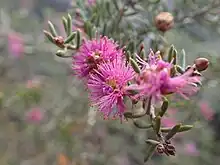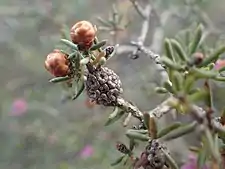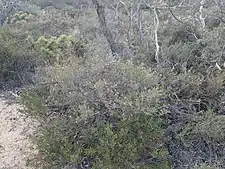| Melaleuca concinna | |
|---|---|
 | |
| Scientific classification | |
| Kingdom: | Plantae |
| Clade: | Tracheophytes |
| Clade: | Angiosperms |
| Clade: | Eudicots |
| Clade: | Rosids |
| Order: | Myrtales |
| Family: | Myrtaceae |
| Genus: | Melaleuca |
| Species: | M. concinna |
| Binomial name | |
| Melaleuca concinna | |
Melaleuca concinna is a small shrub in the myrtle family Myrtaceae and is endemic to the south-west of Western Australia. Its species name translates as " neat" or "pretty" and it is distinguished by having many heads of pink flowers in late spring followed by spherical clusters of woody fruits.


Description
Melaleuca concinna is prickly, spreading shrub to about 1.5 m (5 ft) high. The leaves are arranged alternately, 3.5–13 mm (0.1–0.5 in) long and 1.0–1.8 mm (0.04–0.07 in) wide, almost circular in cross section, with a short stalk (less than 1 mm (0.04 in) long) and a sharp pointed end.
The flowers are arranged in heads, at or near the ends of the branches which continue to grow after flowering. Each head is up to 17 mm (0.7 in) in diameter and contains between 4 and 9 groups of flowers, each group with 3 individual flowers. The base of the flowers is surrounded by white bracts. The petals are 0.8–1.5 mm (0.03–0.06 in) long and fall off as the flower opens. The flowers are surrounded by five bundles of stamens, each bundle containing 3 to 5 pink or purple stamens. The main flowering period is in October and November and is followed by almost spherical clusters of fruit about 7 mm (0.3 in) in diameter.[2][3]
Taxonomy and naming
This species was first formally described in 1852 by the Russian botanist Nikolai Turczaninow in Bulletin de la Société Impériale des Naturalistes de Moscou under the heading Myrtaceae Xerocarpicae in Nova Hollandi.[4][5] The specific epithet (concinna) is from the Latin concinnus meaning "neat", "pretty", or "elegant".[3]
Distribution and habitat
This melaleuca occurs in the south Stirling Range, Jerramungup and Ravensthorpe districts[3] in the Esperance Plains and Mallee biogeographic regions[6] growing in sandy loam over clay or laterite[7] in mallee scrub or heath and along railway lines.[3]
Conservation status
Melaleuca concinna is listed as "not threatened" by the Government of Western Australia Department of Parks and Wildlife.[6]
Use in horticulture
This species is not often cultivated but has been grown successfully in Adelaide.[2]
References
- ↑ "Melaleuca concinna". Plants of the World Online. Retrieved 27 August 2021.
- 1 2 Holliday, Ivan (2004). Melaleucas : a field and garden guide (2nd ed.). Frenchs Forest, N.S.W.: Reed New Holland Publishers. pp. 60–61. ISBN 1876334983.
- 1 2 3 4 Brophy, Joseph J.; Craven, Lyndley A.; Doran, John C. (2013). Melaleucas : their botany, essential oils and uses. Canberra: Australian Centre for International Agricultural Research. p. 126. ISBN 9781922137517.
- ↑ "Melaleuca concinna". APNI. Retrieved 22 March 2015.
- ↑ Turczaninow, Nikolai (1852). "Melaleuca concinna". Bulletin de la Société Impériale des Naturalistes de Moscou. 10: 326. Retrieved 22 March 2015.
- 1 2 "Melaleuca concinna". FloraBase. Western Australian Government Department of Biodiversity, Conservation and Attractions.
- ↑ Paczkowska, Grazyna; Chapman, Alex R. (2000). The Western Australian flora : a descriptive catalogue. Perth: Wildflower Society of Western Australia. p. 392. ISBN 0646402439.